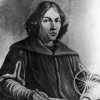Nicolaus Copernicus

Nicolaus Copernicus
Nicolaus Copernicus; German: Nikolaus Kopernikus; 19 February 1473 – 24 May 1543) was a Renaissance mathematician and astronomer who formulated a model of the universe that placed the Sun rather than the Earth at the center of the universe. The publication of this model in his book De revolutionibus orbium coelestiumjust before his death in 1543 is considered a major event in the history of science, triggering the Copernican Revolution and making an important contribution to the Scientific Revolution...
NationalityPolish
ProfessionScientist
Date of Birth19 February 1473
CountryPoland
In the midst of all dwells the Sun. For who could set this luminary in another or better place in this most glorious temple, than whence he can at one and the same time brighten the whole.
The earth together with its surrounding waters must in fact have such a shape as its shadow reveals, for it eclipses the moon with the arc of a perfect circle.
Therefore, having obtained the opportunity from these sources, I too began to consider the mobility of the earth.
In the first book I shall describe all the positions of the spheres, along with the motions which I attribute to the Earth, so that the book will contain as it were the general structure of the universe. In the remaining books I relate the motions of the remaining stars, and all the spheres, to the mobility of the Earth, so that it can be thence established how far the motions and appearances of the remaining stars and spheres can be saved, if they are referred to the motions of the Earth.
In so many and such important ways, then, do the planets bear witness to the earth's mobility.
Among the authorities it is generally agreed that the Earth is at rest in the middle of the universe, and they regard it as inconceivable and even ridiculous to hold the opposite opinion. However, if we consider it more closely the question will be seen to be still unsettled, and so decidedly not to be despised. For every apparent change in respect of position is due to motion of the object observed, or of the observer, or indeed to an unequal change of both.
At rest, however, in the middle of everything is the sun.
I am aware that a philosopher's ideas are not subject to the judgment of ordinary persons, because it is his endeavour to seek the truth in all things, to the extent permitted to human reason by God.
If there should chance to be any mathematicians who, ignorant in mathematics yet pretending to skill in that science, should dare, upon the authority of some passage of Scripture wrested to their purpose, to condemn and censure my hypothesis, I value them not, and scorn their inconsiderate judgement. De Revolutionibus Coelestibus
Mathematics is written for mathematicians.
In the center of all rests the sun. For who would place this lamp of a very beautiful temple in another or better place that this wherefrom it can illuminate everything at the same time? As a matter of fact, not unhappily do some call it the lantern; others, the mind and still others, the pilot of the world. Trismegistus calls it a "visible God"; Sophocles' Electra, "that which gazes upon all things." And so the sun, as if resting on a kingly throne, governs the family of stars which wheel around.
Those things which I am saying now may be obscure, yet they will be made clearer in their proper place.
Moreover, since the sun remains stationary, whatever appears as a motion of the sun is really due rather to the motion of the earth.
Those who know that the consensus of many centuries has sanctioned the conception that the earth remains at rest in the middle of the heavens as its center, would, I reflected, regard it as an insane pronouncement if I made the opposite assertion that the earth moves.